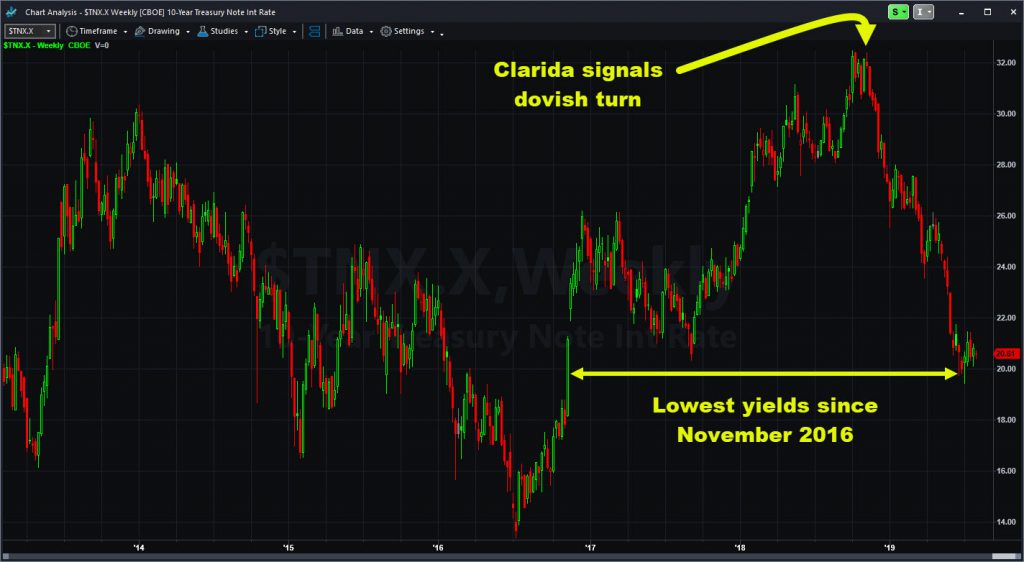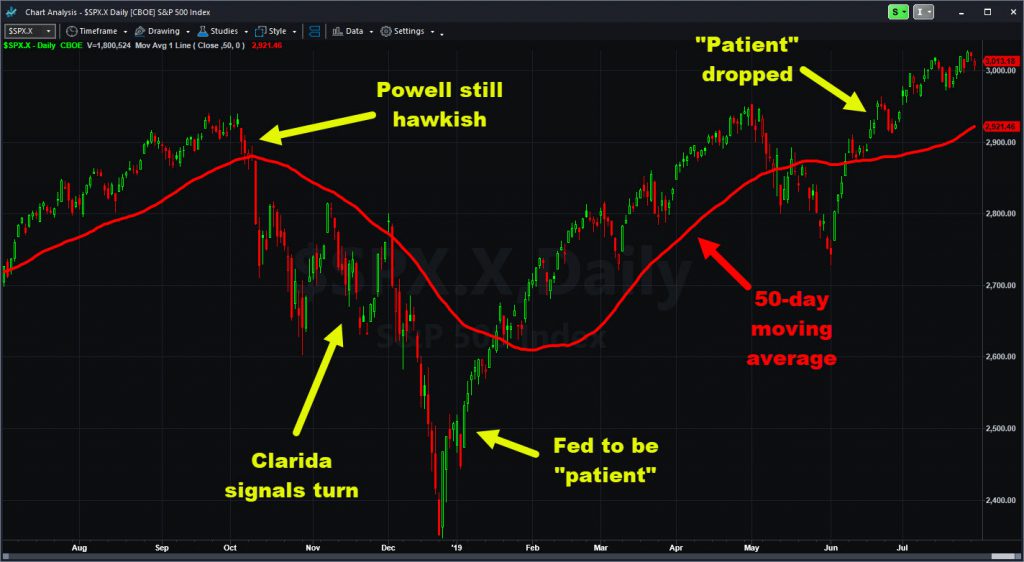Today’s the Fed’s big day.
After nine months of hints, the central bank is expected to cut interest rates for the first time since the financial crisis. Today we wanted to review the Federal Reserve’s morph from “hawkish” to “dovish.” It’s a great study in how policymakers operate, gradually shifting positions in speeches, interviews and official statements. Newer investors may find it especially useful.
In late 2017 and early 2018, central bankers keep signaling interest rates would rise. They did this by calling current policy “accommodative” and talking about the strong economic situation.
This stance continued through October 2018, which would prove to be the market’s worst month in seven years. On October 3, Jerome Powell was still a “long way” from halting rate hikes.

Within a week, President Donald Trump started criticizing the Fed’s stance. He said higher rates weren’t needed because “we have inflation really checked.”
The S&P 500 started crashing the next day. While weakness in major growth stocks like Apple (AAPL) and Netflix (NFLX) was the main reason, the Fed was clearly another factor.
Central bankers kept towing the hawkish line in coming weeks. In a single stretch between Oct. 23 and Oct. 26, at least four policymakers supported more rate hikes. They were: Raphael Bostic of Atlanta, Robert Kaplan of Dallas, Vice Chair Richard Clarida and Loretta Mester of Cleveland.
A Change of Heart
Then on Nov. 16, things started changing. Clarida, Powell’s No. 2 guy, said rates were closer to “neutral.” This was a turn away from the earlier description as “accommodative.” In other words, the Fed started acknowledging rates weren’t too low. A big first step.
That same day, Clarida also recognized pockets of slowing around the world and said U.S. central bankers should be more “data dependent.” Another big step. Only a handful of observers, including Market Insights, noticed the change.
Trump started making noise again on Nov. 27. This time he took to the pages of The Washington Post to bash his own pick as chairman. “I’m not even a little bit happy with my selection,” the president said.

The very next day, Powell reversed course and parroted Clarida. Eight weeks after saying rates were a “long way” from neutral, he declared they were “just below” neutral.
Despite these signals, the Fed didn’t turn on a dime. Policymakers proceeded to raise rates on Dec. 19 because it was previously telegraphed. Not hiking at that moment would have been disruptive and surprising. Central bankers try to avoid that, which is why it can take them so long to make changes.
Dovishness Spreads
Pretty soon Powell was back on script. On Jan. 4, he promised to be “patient” with further rate hikes. At its meeting later in the month, the Fed’s statement dropped mention of “gradual” interest-rate increases.
Powell continued that message in Senate testimony on Feb. 26, warning of risks to the U.S. economy. This is another classic Fed-ism: Don’t talk about interest rates directly. Instead, make the case for raising or lowering them. Talk about the economy being strong or weak. Inflation’s another good subject.
On March 20, the Fed took one more step toward dovishness, officially saying rates wouldn’t go up for the rest of 2019. Still, policymakers kept saying they will be “patient” about increases.
On June 19, they dropped the word “patient.” Forget about any hikes.
On July 10, Powell returned to Congress and warned of “crosscurrents” to the economy. After that, traders started assigning a 100 percent probability to a rate cut today.
This timeline should make clear that Fed policy is like a brick wall, built one piece at a time. Central bankers avoid fast turns. Instead they tear it down brick by brick, and build new ones the same way.
The big question going forward is how stridently they’ll push in their new dovish direction. Keep reading Market Insights for more information as it unfolds.



























